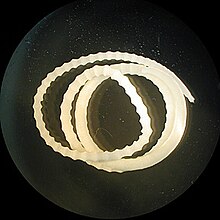| Moniliformidae | |
|---|---|

| |
| Adult Moniliformis moniliformis | |
| Scientific classification | |
| Domain: | Eukaryota |
| Kingdom: | Animalia |
| Phylum: | Acanthocephala |
| Class: | Archiacanthocephala |
| Order: | Moniliformida Schmidt, 1972 |
| Family: | Moniliformidae Van Cleave, 1924 [1] |
Moniliformidae is a family of parasitic spiny-headed (or thorny-headed) worms. It is the only family in the Moniliformida order and contains three genera: Australiformis containing a single species, Moniliformis containing eighteen species and Promoniliformis containing a single species. Genetic analysis have determined that the clade is monophyletic despite being distributed globally. These worms primarily parasitize mammals, including humans in the case of Moniliformis moniliformis, and occasionally birds by attaching themselves into the intestinal wall using their hook-covered proboscis. The intermediate hosts are mostly cockroaches. The distinguishing features of this order among archiacanthocephalans is the presence of a cylindrical proboscis with long rows of hooks with posteriorly directed roots and proboscis retractor muscles that pierce both the posterior and ventral end or just posterior end of the receptacle. Infestation with Monoliformida species can cause moniliformiasis, an intestinal condition characterized as causing lesions, intestinal distension, perforated ulcers, enteritis, gastritis, crypt hypertrophy, goblet cell hyperplasia, and blockages.